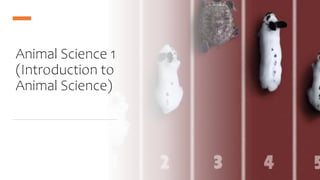
Animal-Science-1-1.pptx
- 1. Animal Science 1 (Introduction to Animal Science)
- 4. Beak/Mouth • A chicken obtains feed by using its beak. Food picked up by the beak enters the mouth. Chickens do not have teeth, so they cannot chew their food. • Mouth contains glands that secrete saliva, which wets the feed to make it easier to swallow. Also, the saliva contains enzymes, such as amylase, that start the digestion process. • The chicken uses its tongue to push the feed to the back of the
- 5. Crop • The crop is an out- pocketing of the esophagus and is located just outside the body cavity in the neck region. • Swallowed feed and water are stored in the crop until they are passed to the rest of the digestive tract. • When the crop is empty or nearly empty, it sends
- 6. Esophagu s • The esophagus is a flexible tube that connects the mouth with the rest of the digestive tract. • It carries food from the mouth to the crop and from the crop to the proventriculus.
- 7. Proventricul us • The esophagus continues past the crop, connecting the crop to the proventriculus. • The proventriculus (also known as the true stomach) is the glandular stomach where digestion primarily begins. Hydrochloric acid and digestive enzymes, such as pepsin, are added to the feed here and begin to break it down more significantly than the
- 8. Ventriculus (Gizzard) • The ventriculus, or gizzard, is a part of the digestive tract of birds, reptiles, earthworms, and fish. • The gizzard is made up of two sets of strong muscles that act as the bird’s teeth and has a thick lining that protects those muscles. • Consumed feed and the digestive juices from the salivary glands and proventriculus pass into
- 9. Pancreas • Pancreas creates natural juices called pancreatic enzymes to break down foods. • These juices travel through your pancreas via ducts. • The upper part of your small intestine called the duodenum.
- 10. Spleen • The spleen is the largest peripheral lymphoid organ in chickens, and it plays a significant role in both antibacterial and antiviral immune responses against acquired antigens.
- 11. Gall bladder • The gall bladder, which stores the bile, is a thin-walled muscular green sac found on the ventral surface of liver. • The liver is the source of the bile which plays an important role in the emulsification of dietary fats, an essential step in fat digestion and absorption.
- 12. Small Intestine • The small intestine is made up of the duodenum (also referred to as the duodenal loop) and the lower small intestine. • The remainder of the digestion occurs in the duodenum, and the released nutrients are absorbed mainly in the lower small intestine. • The duodenum receives digestive enzymes and bicarbonate (to counter the hydrochloric acid from the proventriculus) from the
- 13. Large Intestine (Colon) • The large intestine is actually shorter than the small intestine. • The large intestine is where the last of the water reabsorption occurs.
- 14. Ceca • The ceca (plural form of cecum) are two blind pouches located where the small and large intestines join. • Important function of the ceca is the fermentation of any remaining coarse materials. • During this fermentation, the ceca produce several fatty acids as well as the eight B vitamins (thiamine, riboflavin,
- 15. Cloaca • In the cloaca, the digestive wastes mix with wastes from the urinary system (urates). • Chickens usually void fecal material as digestive waste with uric acid crystals on the outer surface. • The color and texture of chicken fecal material can indicate the health status of the chicken’s digestive tract: the white, pasty material coating chicken fecal material is uric acid, the avian form of
- 17. Ovary • Organ in which yolk formation occurs: yolk is formed in the follicular sac ovarian follicle by the deposition of continuous layers of yolk material.
- 18. Oviduct • The egg moves through the oviduct for about 22 hours. It undergoes a number of modification. • First a thickened outer layer is applied to the vitelline membrane, which has two cord-like extensions, chalazae, which anchor the yolk in center of the egg and stabilize.
- 19. Infundibulum • Also called funnel; the first section of the oviduct that quickly engulfs the yolk with its thin, funnel-like lips.
- 20. Magnum • After passing the infundibulum the yolk quickly enters the magnum section. • The albumen is applied to the outer surface of the egg providing water, nutrients, and antibiotic agents. • The magnum is separated from the isthmus by a narrow, translucent ring w/out glands.
- 21. Isthmus • Is smaller in diameter than the magnum. It is here the two shell membranes are added. • The membranes touch each other throughout the egg, except at the blunt end of the egg, where the air cell is formed later because the egg content cools down and contracts after laying.
- 22. Uterus • Also called shell gland. • The calcite crystals are deposited in and over the out shell membrane layer to form the eggshell.
- 23. Vagina • A thin, protein coating called “bloom” is applied to the shell to keep harmful bacteria or duct from entering the egg shell pores. • The egg is turned horizontally (the process called oviposition) just before laying so that egg will exit blunt end first.
- 24. Thank you!!!
- 25. References: National Institute of Food and Agriculture. U.S. Department of Agriculture. (2023). Dr. Jacquie Jacob, University of Kentucky.